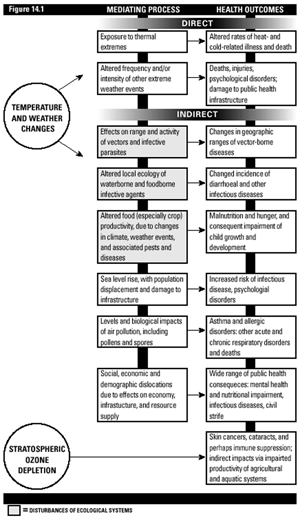 |
| Figure 14.1 |
14.2.1 Potential Health Consequences of Climate Change
The potential health impacts of climate change would occur via pathways of
varying complexity, scale, and directness (Figure 14.1)
(see McMichael et al., 1996 and IPCC, 1996 WGII [Chapter 18]). The limited capacity
for social adaptation in some populations and the unpredictability of social,
economic, demographic change make forecasts of the extent and timing of health
impacts difficult.
The direct adverse impacts on human health are likely to be due to changes
in exposure to temperature extremes (heatwaves) and increases in the frequency
or intensity of other extreme events (floods, cyclones, droughts, etc.). The
extent to which the frequency of extreme weather events will be altered by climate
change remains uncertain, although a changed pattern of floods and droughts
is anticipated. In addition, an increase in winter temperatures may lead to
a decrease in winter mortality (Langford and Bentham, 1995; Martens, 1998),
since many temperate-zone countries experience significantly higher death rates
in winter than in other seasons (Curwen, 1991).
Less direct impacts include net increases or decreases in the geographic distribution
of vector organisms such as malarial mosquitoes. The distribution and abundance
of vectors and intermediate hosts are determined by meteorological factors as
well as by human interventions. Temperature-related changes in the life-cycle
dynamics of vector species and pathogens (helminths, protozoa, bacteria and
viruses) may change the transmission of certain infectious diseases such as
malaria, dengue and leishmaniasis (Patz et al., 1996; Martens, 1998). While
most anticipated change would increase the transmission, decreases would occur
in some locations (Martens, 1998; Faye et al., 1995). Climate change will require
some changes in crops and food production systems. Some regions are likely to
benefit from increased agricultural productivity while others may lose out,
according to their location and dependence on the agricultural sector.
|